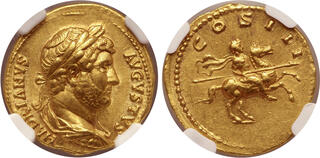| Roma Numismatics Ltd > Auction XXX | Auction date: 21 March 2024 |
| Lot number: 452 Price realized: 6,500 GBP (Approx. 8,234 USD / 7,581 EUR) Note: Prices do not include buyer's fees. | Show similar lots on CoinArchives Find similar lots in upcoming auctions on |
| Lot description: Hadrian AV Aureus. Rome, AD 125-127. HADRIANVS AVGVSTVS, laureate, draped and cuirassed bust to right / COS III, emperor on horseback to right, brandishing spear. RIC II.3 773; C. 414 var. (bust type); BMCRE 438; Biaggi 595 var. (same); Calicó 1226. 7.26g, 20mm, 6h. NGC graded Ch XF 5/5 - 5/5 (#6944528-005). An attractive specimen. Extremely Rare. Ex Roma Numismatics Ltd., Auction XXIII, 24 March 2022, lot 966. This very attractive equestrian aureus was struck to mark the triumphant return to Rome of the Emperor, and shows him riding into the city accepting the honours and praise of the people. Mattingly and Sydenham argue that during his four year absence from Rome there had been little change in the coinage, no development of style, and the mint had been virtually inactive. However, upon his return there was a great new output of coinage, of which this is a stunning example. For his new coinage, Hadrian drops the long legends favoured by his predecessor Trajan, preferring to simplify them to HADRIANVS AVGVSTVS on the obverse and COS III on the reverse. This new obverse legend very distinctly calls into mind the coinage of the first Emperor Augustus, while the new, larger and more gracious style of imperial portrait that fills the fields of the flan is a complete change from the small, careful and cramped types of Trajan. Reverse types such as this one complement the new style and the result is a very attractive and artistic coin. Hadrian's reign was dominated by his extensive travels across the provinces, and indeed he spent more than half of his reign outside of Italy. A known Hellenophile, shortly before the return to Rome that prompted the issue of coinage to which this aureus belongs the Emperor had toured Greece and this, coupled with his studies in Greek academia, art and sculpture led the change to the very Hellenistic design we see here, a piece which can be seen as the product of the highest flourishing of Roman art and sculpture. Although no sculpture or written record of such survives, it is quite probable that this reverse type was modelled on an equestrian statue of Hadrian that stood in Rome and that is lost to us today. We know that numerous equestrian statues of Emperors once graced Rome, and we know that equestrian statues of Hadrian in particular existed - sources corroborate one at Aelia Capitolina on the Temple Mount directly above the Holy of Holies, and another is known to have adorned the Milion built by Constantine I at Constantinople, which along with an equestrian statue of Trajan, must have been removed from its original location and placed there. Indeed, if it were the case that this coin depicts a now lost sculpture, this missing statue would easily fit into a series of imperial equestrian statues that are both well-attested and displayed on the Roman coinage, beginning with the sculpture of Augustus that can be seen on denarii of 16 BC struck under the moneyer L. Vinicius (RIC 362), through Domitian's addition to the Forum Romanum in AD 91 and Trajan's own statue in the Forum Traiani. All of these followed a traditional mode, of which the gilt bronze statue of Marcus Aurelius, which was also featured on that Emperor's coinage and which is preserved in the Capitoline Museum, is the sole surviving example. Estimate: 7500 GBP |  |


